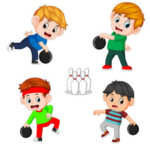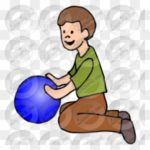
by Neetu | Jun 16, 2020 | Fitness Activity
Posture: Ardhachandra-asana – The Half-moon Pose
(Pronunciation: ard-ha-chun-drah-sa-na)
Description:
The Sanskrit word Ardha means “half,” and the word Chandra means “moon,” thus, this is the “half-moon” posture.
Performing Instructions
- Stand in the tada-asana (Stand with both feet touching from the heel to the big toe, keeping the back straight and the arms pressed slightly against the sides with palms facing inward.
- Bring the hands together at the chest with palms lightly pressed against each other (the Anjali-mudra).
- Inhale and raise the arms straight up keeping the palms pressed lightly together.
- Arch your body backwards keeping your arms alongside your neck and head, tilt the head backward and hold. Keep your knees straight while holding posture.
- Slowly return to the tada-asana.
Comments:
The ardha-chandra-asana is a basic stretching and balancing pose that benefits principly the lower back, abdomen and chest. It isequally suitable for use in your stretching routine as well as formal asana practice.
This pose is also one of the postures that are are sequenced in surya-namaskar (the Sun Salutation).
Duration/Repetitions:
Repeat ardha-chandra-asana two to three times.

by Neetu | Jun 16, 2020 | Fitness Activity
Posture: Anjanaya-asana – The Salutation Pose
(Pronunciation: Ahn-jah-nay-ah-sa-na)
Description: The Sanskrit word Anjaneya means salutation or praise from the root and which means to honor, to celebrate, to anoint.
Performing Instructions
- Sit comfortably in the vajra-asana (thunderbolt pose).
- Kneel up on your knees until your back, buttocks, and thighs are aligned.
- Extend your left foot forward bending your left knee at about a 90-degree angle.
- Place the palms of your hands together at the heart in the Anjali-mudra.
- Raise your arms straight up keeping the palms together while bending the head backward and looking up.
- Slowly bend backward stretching the arms backward and straightening out the right leg. Hold this position for as long as comfortable while breathing gently through the nostrils.
- Come back to the vajra-asana (thunderbolt pose) then reverse the posture by alternating legs.
Comments:
The Anjaneya-asana combines several postures and mudras (gestures) in a fluid, evolving flow that combines motion, stretching, and holds. It delivers great benefits for the back, arms, chest, legs, and hips. Regular practice will strengthen concentration and improve balance.
Perform this posture with a sense of reverence and praise. Take a moment to reside in silence and peace as your hands are held at the heart in the gesture (mudra) of salutation (Anjali-mudra). Keep the intention of praise in mind as you extend your arms skyward. Feel your entire body-mind-heart extending outward in recognition of the sacredness of life.
Duration/Repetitions:
Repeat twice on each side.
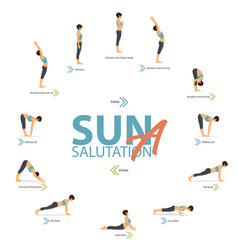
by Neetu | Jun 16, 2020 | Fitness Activity
Posture: Surya-namaskar – Sun Salutation
(Pronunciation: soor-yee-ah-nahma-skar)
Description:
The Sanskrit word Surya means sun. Namaskar is the Hindi word for Namaste, from the root nam, to bow. Namaskar means salutation, salute, greeting, or praise.
STEP ONE:
Stand facing the direction of the sun with both feet touching. Bring the hands together, palm to- palm, at the heart.
STEP TWO:
Stand facing the direction of the sun with both feet touching. Bring the hands together, palm-to-palm, at the heart. Inhale and raise the arms upward. Slowly bend backward, stretching arms above the head.
STEP THREE:
Exhale slowly bending forward, touching the earth with respect until the hands are in line with the feet, head touching knees.
STEP FOUR:
Inhale and move the right leg back away from the body in a wide backward step. Keep the hands and feet firmly on the ground, with the left foot between the hands. Raise the head.
STEP FIVE:
While exhaling, bring the left foot together with the right. Keep arms straight, raise the hips, and align the head with the arms, forming an upward arch.
STEP SIX:
Exhale and lower the body to the floor until the feet, knees, hands, chest, and forehead are touching the ground.
STEP SEVEN:
Inhale and slowly raise the head and bend backward as much as possible, bending the spine to the maximum (as in the naga-asana).
STEP EIGHT:
While exhaling, bring the left foot together with the right. Keep arms straight, raise the hips, and align the head with the arms, forming an upward arch.
STEP NINE:
Inhale and move the right leg back away from the body in a wide backward step. Keep the hands and feet firmly on the ground, with the left foot between the hands. Raise the head.
STEP TEN:
Exhale slowly bending forward, touching the earth with respect until the hands are in line with the feet, head touching knees.
STEP ELEVEN:
Inhale and raise the arms upward. Slowly bend backward, stretching arms above the head.
STEP TWELVE:
Stand facing the direction of the sun with both feet touching. Bring the hands together, palm-to-palm, at the heart.
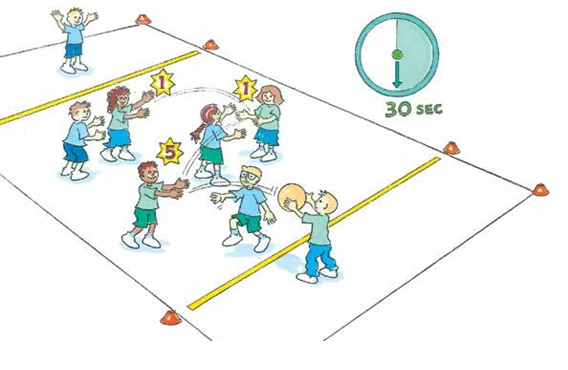
by Santosh | Jun 16, 2020 | Fitness Activity
LEARNING OUTCOME
Develops key defending concepts such as anticipation and spatial awareness.
TEACHING CUES
- Ensure a smooth playing area surface with adequate space between players and other games.
- Enforce the ‘no contact’ rule.
- The ball cannot be taken from another player’s possession.
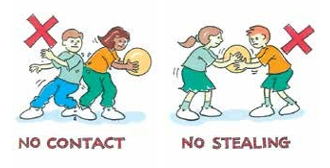
ACTIVITY SET-UP AND PROCEDURE
EQUIPMENT:
- Volleyball/netball court or similar area with end-zones marked
- One ball per group (volleyball size)
- Markers to mark playing area/end-zones
- Coloured bibs
- Stopwatch
SET-UP:
- Attackers score points by passing to each other for 30 seconds.
- For bonus points the ball is passed to a team‑mate in one of the 2 end‑zones.
- Defenders try to intercept the ball. The game is readily adapted to a wide range of ability levels.
ACTIVITY PROCEDURES:
Attackers
- Have 30 seconds to score as many points as possible.
- End‑zone – one attacking player only, all team members have a turn.
- Option – the player passing the final ball has a turn in the end-zone.
Defenders
- Must stand 1m from attackers; no body contact.
- No restriction on the number of defenders in the end zone.
- If the defenders intercept the ball it is placed on the ground for an attacker to resume play. Play continues for attackers until 30 seconds elapses, then the ball changes over.
COOL DOWN/ CLOSURE
Review Skill/Activity, stretching, and questions.
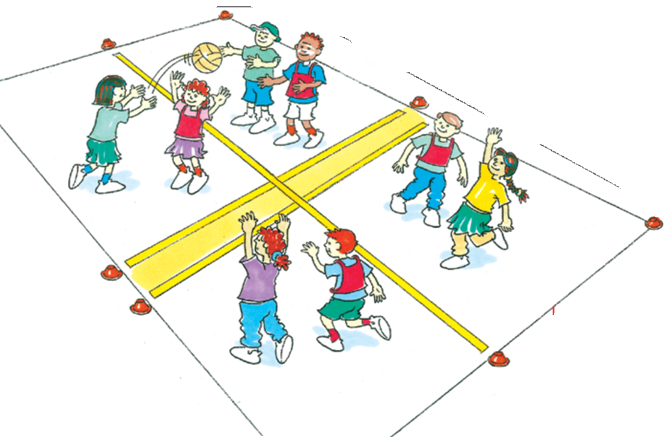
by Santosh | Jun 16, 2020 | Fitness Activity
LEARNING OUTCOME
Develops defending skills and can be easily modified to develop the object control skills of catching, throwing, kicking and striking.
TEACHING CUES
- Try to match the abilities in each square.
- Make sure all players are included
- No physical contact.
ACTIVITY SET-UP AND PROCEDURE
EQUIPMENT:
- The indoor or outdoor playing area
- Variety of balls of different size, weight and density
- 10 marker cones
- Coloured bibs
SET-UP:
- 8 players are divided into 2 teams.
- A playing area is divided into 4 and a player from each team goes into a square.
- The team in possession of the ball passes it to team‑mates in any of the 4 squares, trying to avoid interception.
- Players remain in their square.
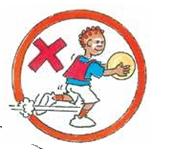
ACTIVITY PROCEDURES:
- One team takes possession of the ball (receivers) and tries to make as many passes as possible between themselves. The other team (interceptors) tries to intercept the ball.
- Players can pass in any direction – no running with the ball.
- All players must remain in their own square.
- If the interceptors catch the ball or knock it out of play, they take possession.
- Winners are those who score the highest number of consecutive passes.
COOL DOWN/ CLOSURE
Review Skill/Activity, stretching, and questions.

by Santosh | Jun 15, 2020 | Fitness Activity
LEARNING OUTCOME
Introduces making and holding shapes in groups, which is needed for many balancing activities
TEACHING CUES
- Make sure players are performing their balance on their mat or soft grass.
- Do not allow players to use their head as a balance option.
- Ensure players securely ‘brace’ one another with appropriate hand grips (e.g. the monkey grip or Roman grip). These must be firm and strong.
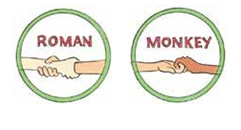
ACTIVITY SET-UP AND PROCEDURE
EQUIPMENT:
1 scatter mat per pair or a soft grassed area
SET-UP:
- Match participants appropriately.
- Make sure players are controlling their exits from the balance.
ACTIVITY PROCEDURES:
- On ‘GO!’, pairs move freely
around the room holding hands until they hear your signal.
- Call out combinations including any of the following: feet, bottom, shoulders, knees, hands, backs, elbows.
- Players find a mat and assume the position called (e.g. if you call out ‘THREE HANDS, TWO FEET!’, pairs form a balance with only these number of body parts touching the ground).
- Players hold their position for a set time (e.g. 10 seconds).
- Players must always be in contact with one another to maintain balance.
Variations:
- Balance with a partner who is of a different size.
- Introduce equipment (such as hoops, balls, and bean bags) that must also be used in the balance.
COOL DOWN/ CLOSURE
Review Skill/Activity, stretching, and questions.













